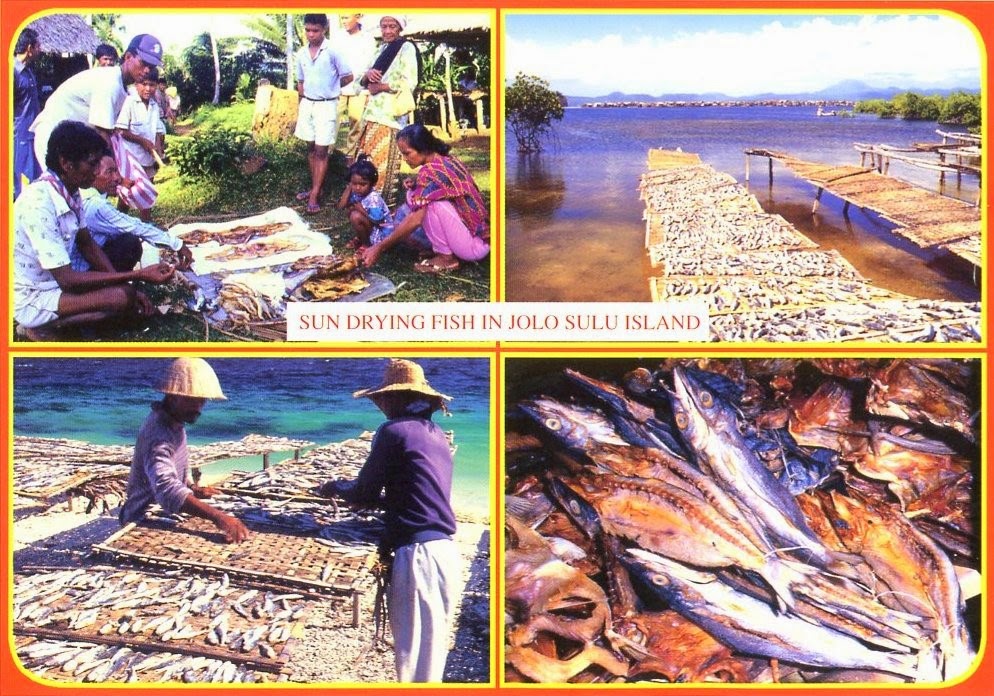Basilan and Jolo Marine Ecology
Basilan
and Jolo is surrounded by two major bodies of water, the Sulu sea in the North
and Celebes sea in the south. Surface currents in
the Sulu Sea arrive from the south in the summer. Winter currents follow an
anti-clockwise gyre. In the Celebes Sea, strong currents, deep sea trench topography,
seamounts and active volcanic islands
result in a complex oceanography. The tropical climate, clear tropical waters
of the Celebes Sea, active underwater volcanoes, seamounts,
trenches, corals and
inter-island passages, currents and upwellings, all make this an
exceptionally rich area
with great marine biodiversity.
Water Quality and Conservation Threats
Years
of overfishing using
dynamite and cyanide have taken their toll on the coral reefs in
the Philippine waters of the Sulu Sea. In Philippine waters the marine
resources are overexploited, as proved by the recent decline in tuna exports.
The exportation of tuna by commercial fishing markets continue
to ignore the ecological limits
of the ecosystem.
Damage to coral communities is caused by careless divers and by boat anchors.
Illegal collectors cause loss of turtle eggs,
giant clams and seashells.
Based
upon sampling of fish tissue at Bathypelagic zone levels,
the Sulu Sea biota demonstrated lower lipid concentrations of DDT, PCBs and
other organochlorine pesticides relative to fish tissue from similar depth
zones in the East China Sea, Tosa Bay and several other locations in the
Indo-Pacific region. The hawksbill turtle became endangered due to the pollution in contamination of these chemicals.
Hawksbill turtle (Eretmochelys imbricata)
The Sulu-Sulawesi Ecoregion have a variety of coral reef plant
and animal life than the rest of the world. It is known as a global centre of
marine biodiversity, and is surrounded largely by Indonesia, Malaysia and the
Philippines. Covering an area of around 900,000km2, the ecoregion is physically subdivided into the Sulu Sea, the
Sulawesi Sea and the inland seas of the Philippines.
Biodiversity and Resources
The Sulu-Sulawesi Ecoregion is of enormous ecological and economic
importance, having diverse ecosystems such as coral reefs, sea grass beds and
mangrove forests. Its marine biodiversity includes more than 400 species of
corals, 650 species of reef fishes, including unusual fishes such as the
coelacanth, 5 of the world's 7 species of marine turtles, endangered marine
mammals such as the dugong, whales and many dolphins, and more than 400 species
of algae and 16 species of sea grass.
The ecoregion also serves as an important source of food and livelihood for
countless subsistence and commercial fishermen. The seas are a crucial spawning
ground for important fish species like the yellow fin tuna and big eye tuna, as
well as shrimp. It is also a tourist destination, a vast marine laboratory for
research and educational purposes.
Many reefs in the ecoregion are under serious stress from social and natural
forces including dynamite fishing, over-fishing, coastal development,
sedimentation, and coral bleaching. Human population density is amongst the
highest in the world, leading to a severe impact on marine ecosystems from
over-exploitation, pollution, and coastal development. There is also a lack of
institutional capacity and political will to enforce environmental protection
laws.
Ongoing initiatives include the Marine Fisheries Programme, intended to review
fishing policies and management and to develop an improved framework, and
ecoregion conservation planning, which aims to formulate a biodiversity vision
and conservation plan for the Sulu-Sulawesi Ecoregion.
Sulu Sulawesi Marine Ecoregion
The Sulu and Celebes Seas comprise the Sulu-Celebes Sea Large Marine
Ecosystem (LME), an area of about 900,000 square kilometers of marine
resources1. The expanse covered by these two seas, also called the Sulu-Sulawesi Marine Ecoregion (SSME),
is partially divided by a chain of small islands known as the Sulu Archipelago.
A large portion of the LME is located in the midst of three ASEAN nations –
Indonesia, Malaysia and the Philippines. The seascape is characterized by a
tropical climate, tepid waters, and complex and wide-ranging biophysical
characteristics and oceanography that contribute to its exceptionally abundant
marine biodiversity. However, the SSME has porous borders acting like a magnet
to threats of piracy and illegal fishing (e.g., cyanide and blast fishing),
which contributes considerably to its environmental degradation2. The
over-exploitation of marine resources, population pressure, and pollution further
undermine its rich legacy.


Coral reefs found in Sulu Sulawesi Marine
Ecoregion
The
multi-gear and multi-species fisheries of this marine ecoregion provide
sustenance and livelihood to some 35 million people. Fishing in the area has
been reported to be excessive and destructive, and has resulted to declining
catches and reduced economic returns, changes in fish population structures,
depleted coral reefs, and heightened threats to rare and endangered species.
Conservation
initiatives in the ecoregion have been taken up by the WWF (i.e., the Sulu
Sulawesi Marine Ecoregion Conservation Program, launched in 1999) and the
Conservation International (i.e., Sulu Sulawesi Seascape Initiative
2005-2010)4. Both NGOs have strategically mobilized the establishment of marine
protected areas, accompanied by law enforcement support in priority conservation
areas, otherwise known as marine biodiversity conservation corridors (MBCCs).
As a result, networks of MPAs have been established, including the social
network of MPAs in the Verde Island Passage Corridor and the network of Marine
Turtle Protected Areas in the Sea Turtle Corridor.
A
2009 report on the Sulu Sulawesi Seascape (SSS) indicated that the SSS
initiative has contributed to the expansion of the total ‘no-take’ zone in
three corridors of the seascape (i.e., the Verde Island Passage, the Cagayan
Ridge and the Tri-national Sea Turtle Corridor) to 1,476 square kilometers,
placing a total of 1,624 square kilometers under management (Figure 28). The
SSS initiative also played a part in the updated mapping of Priority Sites for
Conservation in the Philippines, which is a major contribution to the
Philippines’ Clearing-House Mechanism (discussed separately in this report
under Institutional Initiatives), which will set the trend for similar
undertakings in the ASEAN region.


















